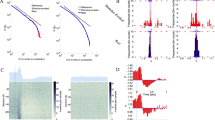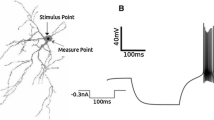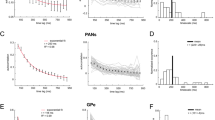Summary
-
1.
The predominant type of response of neurons of the mamillary bodies (MB) is phasic, corresponding strictly to the temporal course of the stimulus.
-
2.
These responses are characterized by different changes, expressing the formation of a trace process: extinction with shortening of the response, extinction with delay of the response, gradual formation of the response.
-
3.
A special role is played by analysis of the temporal parameters of stimuli, including inter-stimulus interval, and is manifested by the ability to analyze various time-dependent effects (extrapolation, reproduction of response configuration in the background activity, reproduction of duration of the original stimulus).
-
4.
The spontaneous activity and responses of MB neurons does not reflect the special features of unit responses in the hippocampus and reticular formation, the major afferent sources for the MB. Evidently the “information” system of cortex and thalamus and the “dynamic” system of hippocampus and reticular formation interact at the MB.
Similar content being viewed by others
References
BAKLAVADZHYAN, O. G. Physiology and Pathology of the Limbic-Reticular Complex. Theses. Moscow, 1968, p. 7.
VINOGRADOVA, O. S. Zh. Vyssh. Nerv. Deyatel. im I. P. Pavlova. 15:500, 1965. (Translation published in Federation Proceedings, Part II, Translation Supplement. 25(3):T397–T403, 1966).
BEKHTEREV, V. V. Zh. Nevropatol. Psikhiat. im. S. S. Korsakova. 5:758, 1912.
KESAREV, V. S. In: Structure and Function of the Nervous System. Moscow, Meditsina, 1965, p. 55.
LEONTOVICH, T. A., Usp. Sovrem. Biol. 65:34, 1968.
MOTORINA, M. V., Zh. Evol. Biokhim. Fiziol. 4:187, 1968.
NAUTA, W. In: Mechanisms of the Whole Brain (Russian translation). Moscow, Foreign Literature Press, 1963, p. 187.
SOKOLOVA, A. A. and T. D. LIPENETSKAYA. Zh. Vyssh. Nerv. Deyatel. im I. P. Pavlova. 18:303, 1968. (Translation published in Neuroscience Translations. No. 6:682–690, 1968–69).
SOLDATOVA, K. A. and N. A. TUSHMALOVA. The Physiology and Pathology of the Limbic-Reticular Complex. Theses. Moscow, 1968, p. 68.
BARBIZET, J. J. Neurol. Neurosurg. Psychiat. 26:127, 1963.
BELL, C., G. SIERRA, N. BUENIDA and J. P. SEGUNDO. J. Neurophysiol. 27: 961, 1964.
BRODAL, A. Brain. 70:179, 1947.
CLARK, W. E. LE GROS and R. H. BOGGON J Anat. 67:215, 1933.
CLARK, W. E. LE GROS and M. MEYER. Brit. Med. Bull. 6:341, 1950.
COWAN, W. M. and T. P. S. POWELL. Proc. Roy. Soc. Ser. B. 143:114, 1955.
DAHL, D., W. R. INGRAM and J. R. KNOTT. Arch. Neurol. Psychiat. 7:314, 1962.
DELAY, J. and S. BRION. Encephale. 43:193, 1954.
DELAY, J., S. BRION and D. ELISSALDE. Presse Med. 66:1965, 1958.
DOTY, R. W., E. C. BECK and K. A. KOOI, Exp. Neurol. 1:360, 1959.
ELLEN, P. and E. W. POWELL. Science. 141:828, 1963.
ERY, W. J., R. KRUMINS, F. J. FRY, G. J. THOMAS, S. BOBERLY and H. ADES. J. Comp. Neurol. 120:195, 1963.
GAMPER, E. Deut. Z. Nervenheilk. 102:122, 1928.
GRÜNTHAL, E. Confin. Neurol. 2:64, 1939.
GUDDEN, G. Arch. Psychiat. Nervenkr. 28:643, 1886.
HORN, G. and R. M. HILL. Nature. 202:296, 1964.
IRWIN, D. and D. McADAM. Electroencephalogr. Clin. Neurophysiol. 20:93, 1966.
KIM, G., H. K. CHANG and J. W. CHU. J. Comp. Physiol. Psychol. 63:469, 1967.
KLEIST, K. In: J. A. BARTH (Editor). Gehirn Pathologie, Leipzig, 1934, p. 1318.
KRIECKHAUS, E. E. Acta Biol. Exp. (Warsaw) 27:319, 1967.
KRIECKHAUS, E. E. and D. RANDALL. Brain. 91:369, 1968.
LUNDBERG, P. O. Acta Physiol. Scand. 49, Suppl. 171, 1960.
MAYER, M. Brain. 72:265, 1949.
PAPEZ, J. W. Arch. Neurol. Psychiat. 38:725, 1937.
PLOOG, D. W. and P. D. McLEAN. Exp. Neurol. 7:76, 1963.
POWELL, T. P. S. and W. M. COWAN. J. Anat. (London) 88:489, 1968.
SANTACANA, M. P. and J. DELACOUR. Neuropsychologia. 6:115, 1968.
SIGRIST, F. Helv. Physiol. Pharmacol. Acta. 3:361, 1945.
SWEET, W. H., G. A. TALLAND and F. L. ERVIN. Trans. Amer. Neurol. Ass. 76:112, 1959.
THOMAS, G. J., W. J. FRY, F. J. FRY, D. M. SLOTNICK and E. E. KRIECKHAUS. J. Neurophysiol. 26:857, 1963.
THOMPSON, R. L. and W. F. HAWKINS. Exp. Neurol. 3:189, 1961.
THOMPSON, R. L., S. K. LANGER and I. RICH. Brain. 87:537, 1965.
UHLE, G. Deut. Z. Nervenheilk. 165:446, 1951.
WOODY, C. D. and F. R. IRVIN. Physiol. Behav. 1:273, 1966.
Author information
Authors and Affiliations
Rights and permissions
About this article
Cite this article
Konovalov, V.F., Vinogradova, O.S. Trace phenomena in unit activity of the mamillary bodies. Neurosci Behav Physiol 4, 162–172 (1970). https://doi.org/10.1007/BF01125679
Issue Date:
DOI: https://doi.org/10.1007/BF01125679




